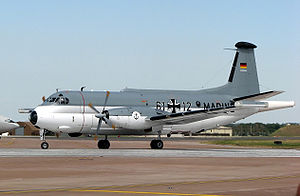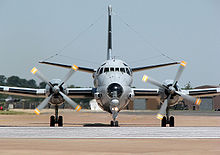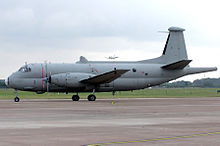- Breguet Atlantic
-
Br.1150 Atlantic
Atlantique 2Breguet Atlantic of the German Navy. Role Maritime patrol aircraft Manufacturer Breguet Aviation First flight 21 October 1961 Status Active service Primary users French Navy
German Navy
Italian Navy
Royal Netherlands NavyProduced 1961 - 1987 Number built 87 Atlantique 1
28 Atlantique 2Unit cost >$35 Million[1] The Breguet Br.1150 Atlantic is a long-range reconnaissance aircraft, primarily designed for use over the sea. It is used in several NATO countries as a reconnaissance and patrol aircraft as well as anti-submarine aircraft. The Atlantic is also capable of carrying air-to-ground missiles. An updated version - the Atlantique 2 - was produced for the French Navy in the 1980s.
Contents
Design and development
In 1958 NATO produced a specification for a long range maritime patrol aircraft to replace the Lockheed Neptune, with Breguet's design, the Br 1150, chosen as the winner of the competition at the end of the year, and a multi-national consortium, Société d'Étude et de Construction de Breguet Atlantic (SECBAT) set up to develop and build the Atlantic.[2]
The first prototype made its maiden flight at Toulouse on 21 October 1961, with the second prototype flying on 25 February 1962, followed by two pre-production aircraft, with a longer fuselage in February 1963 and September 1964.[3]
The Atlantic is a twin-engined, mid-winged monoplane with a "double-bubble" fuselage, with the upper lobe comprising a pressurised crew compartment, and the lower lobe housing a 9 m (27 ft 6 in) long weapons bay, with sonobuoy tubes aft of the weapons bay. A radar scanner is housed in a retractable underfuselage radome, while a magnetic anomaly detector is housed in a tail boom. Power is by two Rolls-Royce Tyne turboprop engines.[4][5]
The Breguet Br.1150 Atlantic has been designed for its purpose, instead of refitting or modifying existing designs. Though the primary mission of the Atlantic is anti-submarine and anti-surface warfare, its secondary role includes search and rescue, mine laying and detection, and long-range maritime surveillance.[6]
The Atlantic can carry either eight guided ASW torpedoes such as Mk 46 Torpedo or 12 depth charges or two AM.39 Exocet Anti-Ship missiles in its internal bomb bay. German Atlantic usually carried Mk 46s only and flew unarmed during the last years of their service.
An initial order for 60 Atlantics, 40 for France and 20 for Germany, was placed in 1963, with deliveries starting in 1965 and continuing to 1968. The production line had shut down by the time that the Netherlands placed an order for nine Atlantics and Italy ordered 18. Aircraft from this second production batch were delivered from 1972 to 1974.[7]
In 1978, the French Government authorised development of a new, updated version of the Atlantic, the Atlantic Nouvelle Generation (later known as the Atlantique 2 when orders from other nations did not occur). While airframe and engines of the new aircraft changed little, other equipment and avionics were considerably revised, with a new radar, a new sonar processor and tactical computer, with a FLIR turret under the nose. The ability to carry Exocet missiles was also added.[8] Two prototype Atlantique 2s were produced by converting existing Atlantics, with the first flying on 8 May 1981, with production being authorised on 24 May 1984.[5] Deliveries started in 1989, with 28 eventually built, from an original requirement for 42.[9][10]
Operational history
The Royal Netherlands Navy lost three Atlantics out of nine aircraft in a series of failures over the Atlantic Ocean, resulting in the grounding of the type in 1981 and its eventual replacement by the P-3 Orion. The German Marineflieger never lost a single plane from 1963 to 2005, although one was written off in an accident. The German Atlantics were replaced by the same P-3 Orion airframes the Netherlands had bought in the 1980s to replace the Atlantic, however meanwhile these aircraft were significantly modernized and upgraded, making them state-of-art maritime patrol aircraft.
In 1999, a Pakistan Navy Atlantic was shot down by Indian Air Force MiG-21s after they failed to force it to land at an Indian base, raising tensions in the region, in what was dubbed the Atlantique Incident. Disobeying instructions from the MiG pilots, the Atlantic maneuvered to escape from them and was shot down by a heat-seeking air-to-air missile over the Rann of Kutch region.
Several German Atlantics have been donated to museums, including the Luftwaffenmuseum and the Dutch Air Force Museum, Soesterberg, Netherlands.[11]
A Breguet Atlantic, referred to in news reports as an Atlantic Model 2, was used by the French Army in the search for parts of Air France Flight 447.[12][13][14]
Accidents and incidents
- May 18, 1986 - While flying through a cloud-covered sky, a French Navy Atlantic crashed into a mountain in Djibouti, killing all 19 people on board.
- August 10, 1999 - At the Pakistani-Indian border, 16 Pakistani Naval airmen were killed in the Atlantique Incident, just a month after the Kargil War.
Variants
- Br.1150 Atlantic
- Atlantique 2
Operators
- French Navy
- French Naval Aviation - The original model was retired in 1996. Second generation Atlantique 2 in service.
- German Navy - Received 20 Atlantics, with five converted as ELINT aircraft.[15] Replaced all ASW aircraft by ex-Dutch P-3 Orion in 2005, while the remaining ELINT version will be replaced by the EuroHawks.
- Italian Navy - Flown by pilots from the Italian Air Force and navy, but commanded by the navy.[citation needed]
- Royal Netherlands Navy
- Dutch Naval Aviation Service - Replaced by the P-3 Orion.
- Pakistan Navy
- Pakistan Naval Air Arm
Specifications (Atlantique 2)
Data from Jane's All The World's Aircraft 1988-89 [5]
General characteristics
- Crew: 12
- Capacity: 12 passengers or relief crew
- Length: 31.62 m (103 ft 9 in)
- Wingspan: 37.42 m (122 ft 9¼ in [16])
- Height: 10.89 m (35 ft 8¾ in)
- Wing area: 120.34 m² (1,295.3 sq ft)
- Empty weight: 25,700 kg (56,659 lb)
- Loaded weight: 45,000 kg (99,200 lb)
- Max takeoff weight: 46,200 kg (101,850 lb)
- Powerplant: 2 × Rolls-Royce Tyne RTy.20 Mk 21 2-shaft turboprops, 6,100 ehp (4,549 kW) each
Performance
- Maximum speed: 648 km/h (350 knots, 402 mph)
- Cruise speed: 315 km/h (170 knots, 195 mph) (patrol speed)
- Stall speed: 167 km/h (90 knots, 104 mph) flaps down
- Ferry range: 9,075 km (4,900 nmi, 5,635 mi)
- Endurance: 18 hours
- Service ceiling: 9,145 m (30,000 ft)
- Rate of climb: 14.7 m/s (2,900 ft/min) at 30,000 kg (66,140 lb)
Armament
- Up to 3,500 kg (7,700 lb), including torpedoes, depth charges, mines, anti-ship missiles, bombs and/or buoys
See also
- Aircraft of comparable role, configuration and era
- Avro Shackleton
- Boeing P-8 Poseidon
- Hawker Siddeley Nimrod
- Kawasaki XP-1
- Lockheed P-3 Orion
- A319 MMA/MPA
- Bombardier Aerospace DHC-8-MPA-D8
- Ilyushin Il-38
- Related lists
References
- Citations
- ^ Defence Journal of Pakistan referring to the cost of the airplane with reference to its downing in the Atlantique Incident
- ^ Air International November 1981, pp. 218, 252.
- ^ Air International November 1981, p.252.
- ^ Air International November 1981, pp. 213–216.
- ^ a b c Taylor 1988, pp. 71–73.
- ^ Naval Technology
- ^ Air International November 1981, pp. 252–253.
- ^ Air International November 1981, pp. 216–218.
- ^ Lambert 1993, pp. 81–82.
- ^ Penny, Stewart. "Military Aircraft Directory Part 1". Flight International, 4 August 1999.
- ^ Airforce Museum
- ^ "Search Teams Converge on Presumed Air France Crash Zone", Washington Post, June 1, 2009
- ^ "French army air crewman aboard an Atlantic Model 2 aircraft", Associated Press, June 2, 2009
- ^ "An Atlantic Model 2 aircraft lands at France's air base in Dakar", Associated Press, June 2, 2009
- ^ Donald and Lake 1996, p.121.
- ^ including wingtip pods
- Bibliography
- Eden, Paul, ed. The Encyclopedia of Modern Military Aircraft. London, UK: Amber Books, 2004. ISBN 1-904687-84-9.
- Donald, David and Jon Lake. (editors). Encyclopedia of World Military Aircraft. London:Aerospace Publishing, Single Volume edition, 1996. ISBN 1-874023-95-6.
- Lambert, Mark. (editor). Jane's All The World's Aircraft 1993-94. Coulsdon, UK:Jane's Data Division, 1993. ISBN 0-7106-1066-1.
- "The New Generation Atlantics". Air International, November 1981, Vol. 21 No. 5. pp. 213–218, 252–253.
- Taylor, John W. R. (editor). Jane's All the Worlds Aircraft 1988-89. Coulsdon, Surrey, UK: Jane's Information Group, 1988. ISBN 0-7106-0867-5.
- Wilson, Stewart. Combat Aircraft since 1945. London: Aerospace Publications, 2000. ISBN 1-875671-50-1.
External links
- Présentation des Atlantique 2 Site de la Marine nationale
- Un ATL2 en jungle guyanaise Site de la Marine nationale
- Industrie Konsortium SECBAT in der Betreuungsphase
- Beschreibung bei EADS
- Beschreibung der BR 1150 bei der Deutschen Marine
- Französische Seite mit Beschreibung der SECBAT
- http://www.naval-technology.com/projects/atlantique/index.html
Aircraft produced by Breguet Aviation Type I • Type II • Type III • Type IV (1910) • Type IV (1914) • Type V
4 • 5 • 6 • 12 • 14 • 16 • 17 • 19 • 20 • 22 • 26T • 27 • 230 • 270 • 271 • 273 • 274 • 280T • 390T • 392T • 393T • 460 • 470 • 482 • 500 • 521 • 522 • 530 • 690 • 691 • 693 • 694 • 695 • 696 • 730 • 731 • 790 • 791 • 792 • 890 • 891 • 892 • 893 • 894 • 895 • 940 • 941 • 960 • 1001 • 1002 • 1004 • 1050 • 1150
Alizé • Atlantic • Atlantique 2 • Bizerte • BLC • BUC • BUM • Colmar • de Chasse • Épaulard • Fulgar • Mars • Mercure • Nautilus • Saigon • Taon • Vultur
Lists relating to aviation General Aircraft (manufacturers) · Aircraft engines (manufacturers) · Airlines (defunct) · Airports · Civil authorities · Museums · Registration prefixes · Rotorcraft (manufacturers) · TimelineMilitary Accidents/incidents Records Categories:- French patrol aircraft 1960–1969
- Breguet aircraft
Wikimedia Foundation. 2010.



